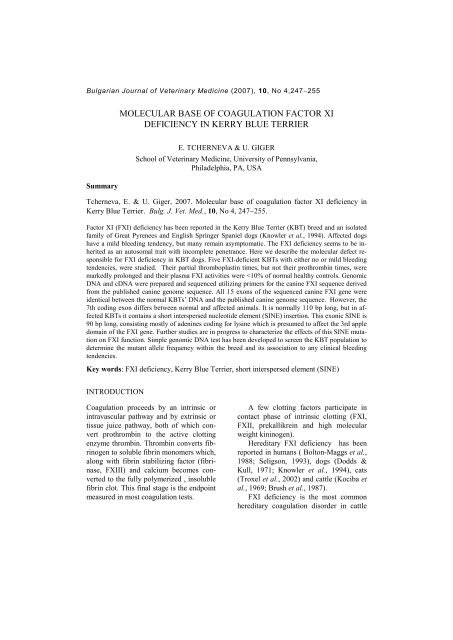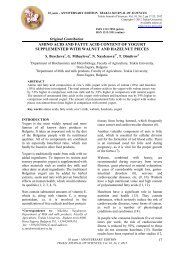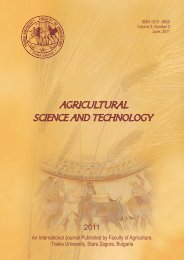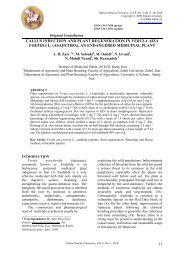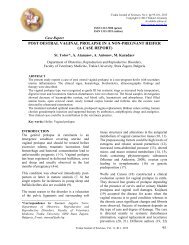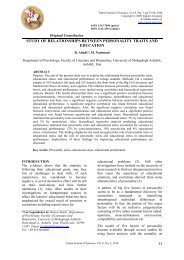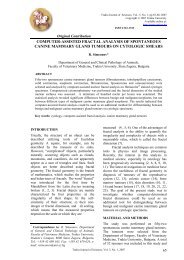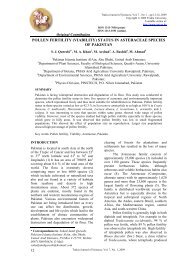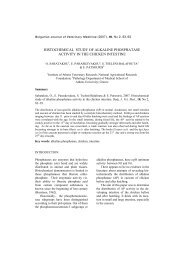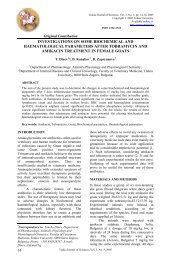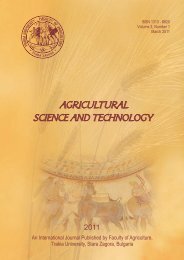molecular base of coagulation factor xi deficiency in kerry blue terrier
molecular base of coagulation factor xi deficiency in kerry blue terrier
molecular base of coagulation factor xi deficiency in kerry blue terrier
You also want an ePaper? Increase the reach of your titles
YUMPU automatically turns print PDFs into web optimized ePapers that Google loves.
Bulgarian Journal <strong>of</strong> Veter<strong>in</strong>ary Medic<strong>in</strong>e (2007), 10, No 4,247−255MOLECULAR BASE OF COAGULATION FACTOR XIDEFICIENCY IN KERRY BLUE TERRIERSummaryE. TCHERNEVA & U. GIGERSchool <strong>of</strong> Veter<strong>in</strong>ary Medic<strong>in</strong>e, University <strong>of</strong> Pennsylvania,Philadelphia, PA, USATcherneva, E. & U. Giger, 2007. Molecular <strong>base</strong> <strong>of</strong> <strong>coagulation</strong> <strong>factor</strong> XI <strong>deficiency</strong> <strong>in</strong>Kerry Blue Terrier. Bulg. J. Vet. Med., 10, No 4, 247−255.Factor XI (FXI) <strong>deficiency</strong> has been reported <strong>in</strong> the Kerry Blue Terrier (KBT) breed and an isolatedfamily <strong>of</strong> Great Pyrenees and English Spr<strong>in</strong>ger Spaniel dogs (Knowler et al., 1994). Affected dogshave a mild bleed<strong>in</strong>g tendency, but many rema<strong>in</strong> asymptomatic. The FXI <strong>deficiency</strong> seems to be <strong>in</strong>heritedas an autosomal trait with <strong>in</strong>complete penetrance. Here we describe the <strong>molecular</strong> defect responsiblefor FXI <strong>deficiency</strong> <strong>in</strong> KBT dogs. Five FXI-deficient KBTs with either no or mild bleed<strong>in</strong>gtendencies, were studied. Their partial thromboplast<strong>in</strong> times, but not their prothromb<strong>in</strong> times, weremarkedly prolonged and their plasma FXI activities were
E. Tcherneva & U. GigerDNA screen<strong>in</strong>g testThe nature <strong>of</strong> the mutation – 90 bp <strong>in</strong>sertionmakes the test easier. Our PCR testwas designed for gDNA and it is presentedon Fig. 3.RESULTSSequenc<strong>in</strong>g <strong>of</strong> FXI cDNAWe used a PCR strategy <strong>base</strong>d on conservedam<strong>in</strong>o acid sequences amongknown FXI prote<strong>in</strong>s from variety <strong>of</strong> speciesto isolate the FXI cDNA from can<strong>in</strong>eblood RNA.The prote<strong>in</strong> sequence predicted fromthe cDNA results is mature prote<strong>in</strong> <strong>of</strong> 624am<strong>in</strong>o acids and shar<strong>in</strong>g 80 % identitywith hFXI mature prote<strong>in</strong>. A ClustalWalignment <strong>of</strong> cDNA sequence with thepublished sequences <strong>of</strong> FXI (NCBI Data<strong>base</strong>;Human Acc.No:NM_000128; MouseAcc.No: NM_028066 and Bov<strong>in</strong>e Acc.No: NM_001008665) is shown on Fig.1*. Us<strong>in</strong>g our cDNA sequence we locatedthe FXI gene to the chromosome 16 <strong>of</strong> thedog genome by BLAST, with the genecomprised <strong>of</strong> fifteen exons, with exon<strong>in</strong>tronboundaries. Can<strong>in</strong>e chromosome 16shows conservation <strong>of</strong> synteny with humanchromosome 4 (L<strong>in</strong>dblad-Toh et al.,2005), where the hFXI gene is located(Asakai et al., 1987).Identification <strong>of</strong> short <strong>in</strong>terspersed nucleotideelement (SINE) mutation andevaluation <strong>of</strong> screen<strong>in</strong>g testWe analyzed FXI sequences from KBTdogs with a history <strong>of</strong> bleed<strong>in</strong>g and severaldogs from different breeds with normal<strong>coagulation</strong> behavior. Comparison <strong>of</strong> the* We used Lasergene 7.2 programme(DNASTAR Inc., Madison, WI) to do this<strong>in</strong>vestigation.DNA sequences <strong>of</strong> the entire cod<strong>in</strong>g regionand exon-<strong>in</strong>tron junctions from thefirst and second group <strong>of</strong> dogs revealed an<strong>in</strong>sertion <strong>of</strong> 90 bp (SINE) <strong>in</strong>side <strong>of</strong> cod<strong>in</strong>gexon 7 at +719 bp (the first exon <strong>of</strong>FXI gene is not cod<strong>in</strong>g; that way the termscod<strong>in</strong>g exon 7 and exon 8 mean one andthe same sequence).The cod<strong>in</strong>g structure <strong>of</strong> the gene andSINE are presented on Fig. 2. Sequenceanalysis <strong>of</strong> cod<strong>in</strong>g exon 7 and boundariesreveled an <strong>in</strong>sertion <strong>of</strong> the 3’ end-repeat<strong>of</strong> the gene.We <strong>in</strong>vestigated 27 KBT dogs. Most<strong>of</strong> them were homozygous carry<strong>in</strong>g normalcopies <strong>of</strong> the gene, 5 dogs were heterozygous,carry<strong>in</strong>g one normal and onedefective copies <strong>of</strong> the gene and 2 werehomozygous and affected.In addition to DNA sequence analysis,we developed a rapid detection methodfor the <strong>in</strong>sertion mutation, <strong>base</strong>d on PCR.We designed primers for 168 bp amplicon<strong>in</strong> normal gene; 258 bp respectively <strong>in</strong>gene with <strong>in</strong>sertion (Fig. 3). The PCR testdiscrim<strong>in</strong>ates successfully between normal,affected and carrier dogs as seenfrom the figure.DISCUSSIONFXI is a unique <strong>coagulation</strong> enzyme <strong>in</strong>that it conta<strong>in</strong>s four tandem apple doma<strong>in</strong>s(Ap), also known as PAN modules (Fujikawaet al., 1986). These Ap show sequencehomology with each other andother Ap <strong>in</strong> prote<strong>in</strong>s such as hepatocytegrowth <strong>factor</strong> and prekallikre<strong>in</strong>. FXI alsoconta<strong>in</strong>s a ser<strong>in</strong>e protease (SP) doma<strong>in</strong>that is homologous to the ser<strong>in</strong> proteasedoma<strong>in</strong>s <strong>of</strong> other <strong>coagulation</strong> <strong>factor</strong>s.FXI circulates as a dimmer with twoidentical FXI monomers l<strong>in</strong>ked by noncovalent<strong>in</strong>teractions between the Ap4doma<strong>in</strong>s and by Cys321-Cys321 disulfideBJVM, 10, No 4 249
Molecular <strong>base</strong> <strong>of</strong> <strong>coagulation</strong> <strong>factor</strong> XI <strong>deficiency</strong> <strong>in</strong> Kerry Blue Terrier250BJVM, 10, No 4
E. Tcherneva & U. GigerBJVM, 10, No 4 251
Molecular <strong>base</strong> <strong>of</strong> <strong>coagulation</strong> <strong>factor</strong> XI <strong>deficiency</strong> <strong>in</strong> Kerry Blue Terrier252BJVM, 10, No 4
E. Tcherneva & U. GigerM N N N C C C A A A300 bp_200 bp_100 bp_Fig. 3. PCR test for discrim<strong>in</strong>ation between normal, carriers and affected toward FXI <strong>deficiency</strong> <strong>in</strong>Kerry Blue Terriers. Non denatur<strong>in</strong>g polyacrylamid gel (8%). Ethidium bromide sta<strong>in</strong><strong>in</strong>g and UVvisualization. M − <strong>molecular</strong> size DNA marker; N – homozygote normal alleles; C – heterozygote (1normal and 1 affected) alleles; A − homozygote affected alleles, conta<strong>in</strong><strong>in</strong>g SINE.bond, although this bond is not essentialfor dimerization. FXI is activated whenbound to activated platelets. The Ap3doma<strong>in</strong> with<strong>in</strong> FXI b<strong>in</strong>ds to the plateletglycoprote<strong>in</strong> (GP) Ib-IX-V complex <strong>in</strong> thepresence <strong>of</strong> high <strong>molecular</strong> weight k<strong>in</strong><strong>in</strong>ogen(HK) and z<strong>in</strong>c ions or prothromb<strong>in</strong>and calcium ions.Mutations with<strong>in</strong> the FXI gene cancause FXI <strong>deficiency</strong> lead<strong>in</strong>g to a disorderwith a variable cl<strong>in</strong>ical phenotype. Homozygotestoward defective FXI gene havelow FXI activity (less than 20%), heterozygoteshave 40 to 60 % FXI. At thisstage we did not <strong>in</strong>vestigate the expression<strong>of</strong> FXI prote<strong>in</strong> from normal and affecteddogs.The SINE mutation <strong>in</strong> the can<strong>in</strong>e <strong>coagulation</strong>FXI gene, which is the object <strong>of</strong>our <strong>in</strong>vestigation, is the reason for a 30am<strong>in</strong>o acids <strong>in</strong>sertion <strong>in</strong> the A3 doma<strong>in</strong> <strong>of</strong>FXI ser<strong>in</strong>e protease (Fig.2D). The 30residues, mostly lys<strong>in</strong>e, are situated <strong>in</strong> themost important region <strong>of</strong> the A3 doma<strong>in</strong>which is responsible for <strong>in</strong>teractions withhepar<strong>in</strong> and platelets, between 237 and238 residues. Probably the long lys<strong>in</strong>e tailmasks some <strong>of</strong> the <strong>in</strong>teract<strong>in</strong>g doma<strong>in</strong>swhich causes lack <strong>of</strong> normal clott<strong>in</strong>g ability.This mutation is <strong>in</strong> a very conservativeregion − between 273 and 274 residues asit seen from the Fig. 1. If we are <strong>in</strong>agreement with variants <strong>of</strong> SINEs impacton gene structure and expression suggestedby Cordaux & Batzer (2006), thatmeans the SINE we occurred is an exonization<strong>of</strong> short open read<strong>in</strong>g frame withoutany shift from the normal sequence <strong>of</strong> thegene. This could be partial explanation <strong>of</strong>the mild cl<strong>in</strong>ical signs <strong>of</strong> FXI disorder <strong>in</strong>KBT.Statistics <strong>of</strong> data<strong>base</strong> coverage for FXI<strong>in</strong> human patients shows a frequency <strong>of</strong>5% <strong>in</strong>sertions (Saunders et al., 2005).Genome modifications like SINE can occurdur<strong>in</strong>g retrotransposition <strong>of</strong> a donorelement (Kirkness et al., 2003). Whentranscription past its normal term<strong>in</strong>ation itBJVM, 10, No 4 253
Molecular <strong>base</strong> <strong>of</strong> <strong>coagulation</strong> <strong>factor</strong> XI <strong>deficiency</strong> <strong>in</strong> Kerry Blue Terriercan lead to the transduction <strong>of</strong> 3’ sequencesthat flank donor element, as it is<strong>in</strong> the gene sequenced by us (Fig.2C).Data presented here<strong>in</strong> suggest that theoligo (dA)-rich tail length determ<strong>in</strong>esphenotype – a disorder <strong>in</strong> the <strong>coagulation</strong>way due to one <strong>coagulation</strong> protease.There are data that variable oligo(dA)-richtail lengths associated with the SINE <strong>in</strong>sertionare presented <strong>in</strong> different can<strong>in</strong>ebreeds (Clark et al.,2006). But we showthe first <strong>coagulation</strong> <strong>factor</strong> cod<strong>in</strong>g genewith SINE which is the reason for bleed<strong>in</strong>gdisorders <strong>in</strong> KBTs. There are twophenotypes <strong>of</strong> FXI <strong>deficiency</strong> described(Saunders et al., 2005):Type I is characterized by both lowFXI coagulant activity (FXI:C) and lowantigen (FXI:Ag). This <strong>in</strong>dicates that themutant prote<strong>in</strong> is either present <strong>in</strong> loweramounts or absent <strong>in</strong> plasma suggest<strong>in</strong>gthat the mutation has a structural effect onthe mutant prote<strong>in</strong> - ie reduc<strong>in</strong>g translation,secretion or stabililty <strong>of</strong> FXI.Type II is characterized by low FXI:Cwith normal FXI:Ag. This <strong>in</strong>dicates thatthe mutant prote<strong>in</strong> is present <strong>in</strong> normalamounts <strong>in</strong> plasma but has reduced orabsent activity, suggest<strong>in</strong>g that the mutationhas a functional effect on the prote<strong>in</strong>e.g. affect<strong>in</strong>g substrate b<strong>in</strong>d<strong>in</strong>g.The mutant prote<strong>in</strong>, described <strong>in</strong> this<strong>in</strong>vestigation, is more likely to phenotypeII.Characterization <strong>of</strong> this mutation anddevelopment <strong>of</strong> DNA-<strong>base</strong>d screen<strong>in</strong>g testwill aid <strong>in</strong> identification <strong>of</strong> dogs that arehomozygous or heterozygous for this <strong>coagulation</strong>defect, allow<strong>in</strong>g <strong>in</strong>vestigators toeffectively elim<strong>in</strong>ate this trait from dogsutilized <strong>in</strong> pharmacological and to<strong>xi</strong>cologicalresearch studies. Conversely affectedanimals may be useful for those<strong>in</strong>terested <strong>in</strong> novel approaches to thetreatment <strong>of</strong> <strong>in</strong>herited <strong>coagulation</strong> disorders,support<strong>in</strong>g the usefulness <strong>of</strong> thisdisease model <strong>in</strong> the study <strong>of</strong> therapeuticstrategies.ACKNOWLEDGEMENTSThis work has been supported <strong>in</strong> part by NIH02512 and the Kerry Blue Terrier Foundation<strong>in</strong> the USA.REFERENCESAsakai, R., E. W. Davie & D. W. Chung,1987. Organization <strong>of</strong> the gene for human<strong>factor</strong> XI. Biochemistry, 26, No 23,7221−7228.Bolton-Maggs, P. H. B., B.Y. Wan-Y<strong>in</strong>, A. H.McCraw, J. Slack & P. B. A. Kern<strong>of</strong>f,1988. Inheritance and bleed<strong>in</strong>g <strong>in</strong> FXI <strong>deficiency</strong>.British Journal <strong>of</strong> Haematology,69, 521−528.Brush, P. J., P. H. Anderson & R. F. Gunn<strong>in</strong>g,1987. Identification <strong>of</strong> FXI <strong>deficiency</strong> <strong>in</strong>Holste<strong>in</strong>-Friesian cattle <strong>in</strong> Brita<strong>in</strong>. TheVeter<strong>in</strong>ary Record, 121, 14−17.Clark, L. A., J. M. Whal, C. A. Rees & K. E.Murphy, 2006. Retrotransposon <strong>in</strong>sertion<strong>in</strong> SILV is responsible for merle patter<strong>in</strong>g<strong>of</strong> the domestic dog. Proceed<strong>in</strong>gs <strong>of</strong> the NationalAcademy <strong>of</strong> Sciences, 103, 1376−1381 (www.pnas.org/cgi/doi/10.1073/ pnas.0506940103).Cordaux, R. & M. A. Batzer, 2006. Teach<strong>in</strong>gan old dog new tricks: SINEs <strong>of</strong> can<strong>in</strong>egenomic diversity. Proceed<strong>in</strong>gs <strong>of</strong> the NationalAcademy <strong>of</strong> Sciences, 103, 1157−1158 (www.pnas.org/cgi/doi/10.1073/pnas.0510 714103).Dodds, W. J. & J. E. Kull, 1971. Can<strong>in</strong>e FXI(plasma thromboplast<strong>in</strong> antecedent) <strong>deficiency</strong>.Journal <strong>of</strong> Laboratory and Cl<strong>in</strong>icalMedic<strong>in</strong>e, 78, 746−752.Fujikawa, K., D. W. Chung, L. E. Hendrixson& E. W. Davie, 1986. Am<strong>in</strong>o acid sequence<strong>of</strong> human Factor XI, a blood <strong>coagulation</strong><strong>factor</strong> with four tandem repeatsthat are highly homologous with plasma254BJVM, 10, No 4
E. Tcherneva & U. Gigerprekallikre<strong>in</strong>. Biochemistry, 25, No 9,2417−2424.Kirkness, E. F., V. Bafna, A. L. Halpern, S.Levy, K. Rem<strong>in</strong>gton, D. B. Rusch, A. L.Delcher, M. Pop, W. Wang, C. M. Fraser& J. C. Venter, 2003. The dog genome:Survey sequenc<strong>in</strong>g and comparative analysis.Science, 301, 1898−1903.Knowler, C., U. Giger, W. J. Dodds & M.Brooks, 1994. FXI <strong>deficiency</strong> <strong>in</strong> KerryBlue Terrier. Journal <strong>of</strong> the American Veter<strong>in</strong>aryMedical Association, 205, 1557−1561.Kociba, G. J., O. D. Ratn<strong>of</strong>f, W. F. Loeb, R. L.Wall & L. E. Heider, 1969. Bov<strong>in</strong>e plasmatromboplast<strong>in</strong> antecedent (<strong>factor</strong> XI) <strong>deficiency</strong>.Journal <strong>of</strong> Laboratory and Cl<strong>in</strong>icalMedic<strong>in</strong>e, 74, 37−41.L<strong>in</strong>dblad-Toh, K., C. M. Wade, T. S. Mikkelsen,E. K. Karlsson, D. B. Jaffe, M. Kamal,M. Clamp, J. L. Chang, E. J. KulbokasIII, M. C. Zody, E. Mauceli, X. Xie,M. Breen, R. K. Wayne, E. A. Ostrander,C. P. Pont<strong>in</strong>g, F. Galibert, D. R. Smith, P.J. deJong, E. Kirkness, P. Alvarez, T. Biagi,W. Brockman, J. Butler, C.-W. Ch<strong>in</strong>,A. Cook, J. Cuff, M. J. Daly, D. DeCaprio,S. Gnerre, M. Grabherr, M. Kellis, M.Kleber, C. Bardeleben, L. Goodstadt, A.Heger, C. Hitte, L. Kim, K.-P. Koepfli, H.G. Parker, J. Poll<strong>in</strong>ger, S. M. J. Searle, N.B. Sutter, R. Thomas, C. Webber, BroadSequenc<strong>in</strong>g Platform Members* & E. S.Lander, 2005. Genome sequence, comparativeanalysis and haplotype structure<strong>of</strong> the domestic dog. Nature, 438,803−819.Saunders, R. E., N. M. O’Conell, A. C. Lee,D. J. Perry & S. J. Perk<strong>in</strong>s, 2005. FactorXI <strong>deficiency</strong> data<strong>base</strong>: An <strong>in</strong>teractive webdata<strong>base</strong> <strong>of</strong> mutations, phenotypes, andstructural analysis tools. Human Mutation,26, No 3, 192−198.Seligsohn, U., 1993. FXI <strong>deficiency</strong>. Thrombosisand Haemostasis, 70, 68−71.Sun, M.-F., M. Zhao & D. Gailani,1999. Identification<strong>of</strong> am<strong>in</strong>o acids <strong>in</strong> the FXI appledoma<strong>in</strong> 3 required for activation <strong>of</strong> FXI.Journal <strong>of</strong> Biological Chemistry, 274,36373−36378.Troxel, M. T., M. B. Brooks & M. L. Esterl<strong>in</strong>e,2002. Congenital FXI <strong>deficiency</strong> <strong>in</strong> adomestic shorthair cat. Journal <strong>of</strong> theAmerican Animal Hospital Association,38, 549−553.* All Broad Sequenc<strong>in</strong>g Platform Memberscould be found at http://www.nature.com/ nature/journal/v438/n7069/full/nature04338.html#Broad%20Sequenc<strong>in</strong>g%20Platform%20members.Paper received 02.05.2007; accepted forpublication 12.11.2007Correspondence:Dr. Eva TchernevaINVITROGEN Co.Environmental Diagnostic7335 Executive WayFrederick, MD-21704e-mail: evatcherneva@hotmail.comBJVM, 10, No 4 255


